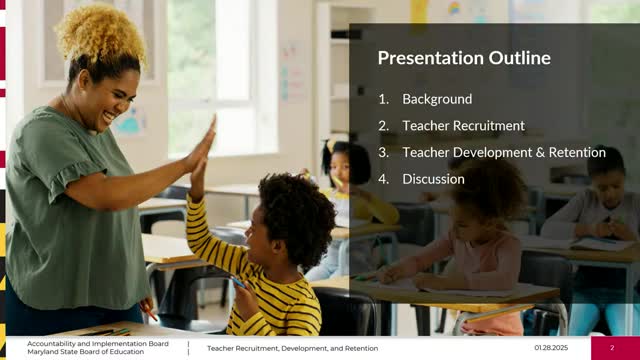Maryland Education Board addresses teacher shortage and implements collaborative time blueprint
January 28, 2025 | Maryland Department of Education, School Boards, Maryland
Thanks to Scribe from Workplace AI , all articles about Maryland are free for you to enjoy throughout 2025!

This article was created by AI using a video recording of the meeting. It summarizes the key points discussed, but for full details and context, please refer to the video of the full meeting. Link to Full Meeting
A key focus of the meeting was the concept of collaborative time, which aims to provide teachers with dedicated periods to work together on curriculum development and student interventions. This initiative is part of a broader educational blueprint that seeks to shift teachers' classroom time from 80% to 60%, allowing for more collaboration and professional development. However, board members acknowledged that the current teacher shortage makes it challenging to implement this plan as envisioned.
The board discussed strategies to enhance the teacher pipeline, including leveraging conditionally licensed teachers—who often come from the communities they serve—as a means to address the shortage. These teachers represent a diverse workforce, with a significant percentage being teachers of color. The board emphasized the importance of creating pathways for these educators to transition to full licensure, which is crucial for improving the overall quality of teaching in Maryland.
In addition to recruitment efforts, the board recognized the need for retention strategies to keep current educators in the classroom. Research indicates that teachers who receive mentorship and professional development are more likely to remain in their positions. The board proposed expanding access to coaching and training for both teachers and school leaders, as effective leadership is linked to higher teacher retention rates.
The meeting also touched on the importance of changing the perception of the teaching profession to attract new educators. Board members discussed the potential for a recruitment campaign to highlight the benefits of teaching in Maryland, including competitive salaries and a commitment to educational investment.
As the board concluded its discussions, it became clear that addressing the teacher shortage requires a multifaceted approach, combining recruitment, retention, and support for educators. The outcomes of this meeting will play a significant role in shaping Maryland's educational landscape and ensuring that all students have access to high-quality teaching.
Converted from Meeting of the Maryland State Board of Education | Tuesday January 28, 2025 | 9 a.m - 4:55 p.m EST meeting on January 28, 2025
Link to Full Meeting
Comments
View full meeting
This article is based on a recent meeting—watch the full video and explore the complete transcript for deeper insights into the discussion.
View full meeting
